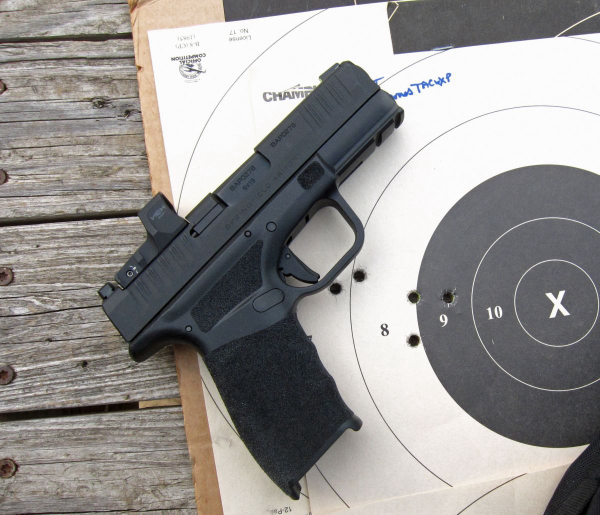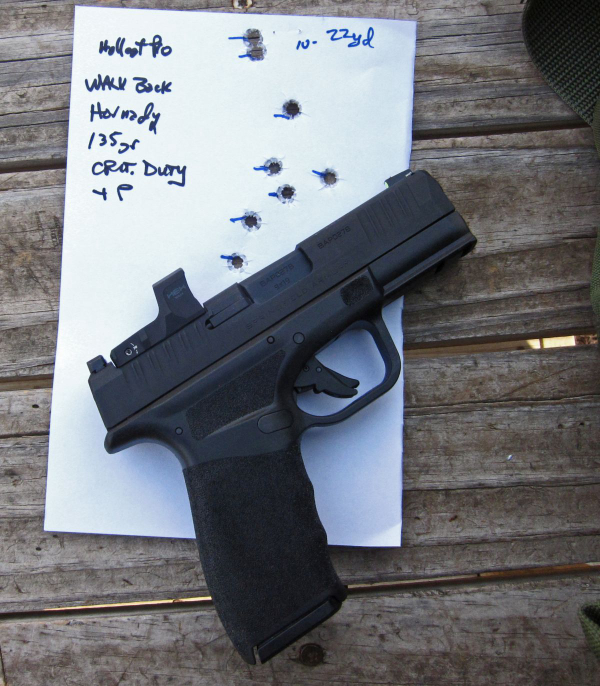Editor’s Note: We promised to keep you posted as we went through more familiarization with Springfield Armory’s Hellcat Pro pistol announced last Friday. Today, Rich Grassi has more on the shooting performance of the new micro-compact.
Last Friday, you saw Jim’s assessment of the new Hellcat Pro pistol from Springfield Armory. I’d received a sample of the pistol, fitted from the factory with the HEX Wasp optic, about mid-week and fired a few rounds from it before the gun was announced.
I’m glad the optic was attached to prevent overuse of my meager mechanical skills, but the gun is sold optics-ready, not (far as I know) with optics mounted.
I have since shot the gun more and have some information.

My first try was only at seven yards – even knowing that a close-range event like that says nearly nothing about whether the optic is zeroed. Those first rounds fired two-handed stayed within the “X” ring of the NRA B-8 bullseye repair center target. Firing five rounds “wrong hand” unsupported and another five right-hand, unsupported and all rounds were in the 10-ring of the B-8 – except for a “convulsive clutch” throwing a single out into the “8”ring.
Getting back out with a small collection of ammo, I sought to shoot groups with the new heater so see if it was really a shooter. The bench was set at 20 yards and I used a range bag for support. I quickly found I was pressing left – shooting at a silhouette from fifty yards showed a pair of rounds within 1 ½” of each other, but all the way to the left edge of the paper.
After shooting groups, I sought to actually zero the HEX Wasp optic. In a moment, I had the round hitting to the right of aim – there are no “click” adjustments on the optic. Bringing it back to the left put the hits center which I later confirmed on a “walk-back” drill.

The HEX Wasp optic makes aiming easy (above) but the supplied irons are some of the best on a factory gun. Below, the optic without confirming zero doesn't help - but the gun's capable of good groups, this with DoubleTap 115gr. Barnes TAC-XP ammo.

In the accuracy test, I found the winner (for these particular loads) was the DoubleTap 115 grain Barnes “TAC-XP” load. It put five hits into 2 1/8” with the best three hits crowding into an inch. Federal Syntech Defense 138gr. JHP tied for second place with Remington Golden Saber 124gr. BJHP. Both rounds produced four-inch groups, the Federal being a vertical string that causes me to question my grip – not the load or ammo. The Federal load put three of those into 2 ½” while the Golden Saber slightly bettered the performance with four hits into 1 3/8”.
I think this Hellcat Pro prefers light-to-midweight 9mm bullets – so far. The Hornady Critical Duty 135gr. FTX +P, a real champ in 4-inch service compacts, produced a six-inch group with the best three clustering into 2 ½”.

The gun was fired with ball ammo, as well as defense ammo, like the Hornady Critical Duty (above). Even with the longer barrel/slide, the gun is still light and snappy (below).

Not yet having a holster that really fit the Hellcat Pro, I had a “close-enough” – or so I thought – rig. Shooting the close course that was my take on the Tactical Professor’s “high percentage” drill with a modification on the Florida Department of Law Enforcement qualification course’s second stage and the Waidelich/Bakersfield PD course – as I know it – on an IALEFI-Q target, showed some difficulties with my technique. My excuse is that I’ve worked for over 20 years to accommodate a gun that’s not all that comfortable for me to shoot. Like the old Border Patrol campaign hat, it was “it won’t fit you; you have to learn to fit it.” It was a “failure” all the way around.


As I shot that before working on the zero of the optic (which wasn’t enough to make a difference), I loaded up with Hornady Critical Duty 135gr FTX +P and some Hornady 124gr XTP +P to do a “walk-back” drill. To confirm zero with my hold, I like to use the Claude Werner Baseline/Dave Elderton variation. I stapled up a halved sheet of copy paper (this actually measured 8 3/8” high by 5 5/8” wide). Starting at about ten yards, I’d deliver a pair then walk back. With eight rounds in the magazine, I got back to 22 yards. Eight hits were on the paper in a cluster that’s 3 5/8” high x 1 ¼” wide (shown).
Thinking that solved my problems, I fired up the PACT Club Timer and posted a B-8 (CP) target. Redoing just the Bakersfield component of my close-up course, I posted ten hits inside the 8-ring and accumulated 13 points worth of time penalties for an 87/100.
Better.
As to the gun, it’s accurate enough and, as noted, it seems to prefer lighter bullets – but this is a small sample size. As to the HEX Wasp optic, it has a number of notable features. The sight body is constructed of aluminum alloy and has serrations on the rear – to prevent glare – and depression cuts on the side to “provide a firm grip in adverse conditions.” The rear of the housing is cut with a “co-witness channel” that allows an unobstructed view of the pistol’s iron sights. The lens is scratch-resistant anti-glare glass, protected by the protruding shroud extending beyond the lens. It is run on a CR2032 battery, is auto-dimming and has a 3.5 MOA dot reticle.
It’s snappy; my overtime shots, I believe, were more related to my handling of the gun – and using a holster that offered a less than optimal fit – than the snappiness of recoil. While it does buck, the course isn’t fast enough (at my best times) that it should matter. I’ve fired it with a “Commander”- length 1911 style pistol in 45 Auto and with polymer frame guns in 40 Auto and passed easily.
This is more a ‘get used to the gun and you’ll get better’ issue – I believe. And I think the performance on the B-8 repair center goes a long way to confirm it.
-- Rich Grassi
